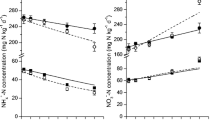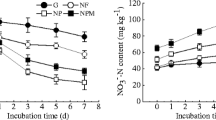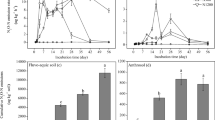Abstract
A better understanding of the nitrogen (N) cycle in agricultural soils is crucial for developing sustainable and environmentally friendly N fertilizer management and to propose effective nitrous oxide (N2O) mitigation strategies. This laboratory study quantified gross nitrogen transformation rates in uncultivated and cultivated black soils in Northeast China. It also elucidated the contribution made by nitrification and denitrification to the emissions of N2O. In the laboratory, soil samples adjusted to 60 % water holding capacity (WHC) were spiked with 15NH4NO3 and NH4 15NO3 and incubated at 25 °C for 7 days. The size and 15N enrichment of the mineral N pools and the N2O emission rates were determined between 0 and 7 days. The results showed that the average N2O emission rate was 21.6 ng N2O-N kg−1 h−1 in cultivated soil, significantly higher than in the uncultivated soil (11.6 ng N2O-N kg−1 h−1). Denitrification was found to be responsible for 32.1 % of the N2O emission in uncultivated soil, and the ratio increased significantly to 43.2 % in cultivated soil, due to the decrease in soil pH. Most of the increase in net N2O-N emissions observed in the cultivated soil was resulting from the increased production of N2O through denitrification. Gross nitrification rate was significantly higher in the cultivated soil than in the uncultivated soil, and the ratio of gross nitrification rate/ammonium immobilization rate was 6.87 in cultivated soil, much larger than the uncultivated soil, indicating that nitrification was the dominant NH4 + consuming process in cultivated soil, and this will lead to the increased production of nitrate, whereas the increased contribution of denitrification to N2O emission promoted the larger emission of N2O. This double impact explains why the risk of N loss to the environment is increased by long-term cultivation and fertilization of native prairie sites, and controlling nitrification maybe effective to abate the negative environmental effects.




Similar content being viewed by others
References
Baggs EM, Stevenson M, Pihlatie M, Regar A, Cook H, Cadisch G (2003) Nitrous oxide emissions following application of residues and fertilizer under zero and conventional tillage. Plant Soil 254:361–370
Bremner JM (1996) Nitrogen-total. In: Sparks DL (Ed) Methods of soil analysis. Part 3. Chemical methods. Soil Science Society of America, Madison, pp 1085–1121
Burford JR, Bremner JM (1975) Relationships between the denitrification capacities of soils and total water soluble and readily decomposable soil organic matter. Soil Biol Biochem 7:389–394
Cai GX, Chen DL, Ding H, Pacholski A, Fan XH, Zhu ZL (2002) Nitrogen losses from fertilizers applied to maize, wheat and rice in the North China Plain. Nutr Cycl Agroecosyst 63:187–195
Cai YJ, Ding WX, Zhang XL, Yu HY, Wang LF (2010) Contribution of heterotrophic nitrification to nitrous oxide production in a long-term N-fertilized arable black soil. Commun Soil Sci Plant Anal 41:2264–2278
Cheng Y, Cai ZC, Zhang JB, Lang M, Mary B, Chang SX (2012) Soil moisture effects on gross nitrification differ between adjacent grassland and forested soils in central Alberta, Canada. Plant Soil 352:289–301
Chu HY, Fujii T, Morimoto S, Lin XG, Yagi K (2008) Population size and specific nitrification potential of soil ammonia-oxidizing bacteria under long-term fertilizer management. Soil Biol Biochem 40:1960–1963
Compton JE, Boone RD (2002) Soil nitrogen transformations and the role of light fraction organic matter in forest soils. Soil Biol Biochem 34:933–943
De Boer W, Kowalchuk GA (2001) Nitrification in acid soils: micro-organisms and mechanisms. Soil Biol Biochem 33:853–866
Fierer N, Schimel JP (2002) Effects of drying-rewetting frequency on soil carbon and nitrogen transformations. Soil Biol Biochem 34:777–787
Fuß R, Ruth B, Schilling R, Scherb H, Munch JC (2011) Pulse emissions of N2O and CO2 from an arable field depending on fertilization and tillage practice. Agric Ecosyst Environ 144:61–68
Garrido F, Hénault C, Gaillard H, Pérez S, Germon JC (2002) N2O and NO emissions by agricultural soils with low hydraulic potentials. Soil Biol Biochem 34:559–575
Gibbs P, Barraclough D (1998) Gross mineralization of nitrogen during the decomposition of leaf protein I (ribulose 1, 5-diphosphate carboxylase) in the presence or absence of sucrose. Soil Biol Biochem 30:1821–1827
Grenon F, Bradley RL, Titus BD (2004) Temperature sensitivity of mineral N transformation rates, and heterotrophic nitrification: possible factors controlling the post-disturbance mineral N flush in forest floors. Soil Biol Biochem 36:1465–1474
Guo JH, Liu XJ, Zhang Y, Shen JL, Han WX, Zhang WF, Christie P, Goulding KWT, Vitousek PM, Zhang FS (2010) Significant acidification in major Chinese croplands. Science 327:1008–1010
Hou XY, Han XZ, Li HB, Xing BS (2010) Composition and organic carbon distribution of organomineral complex in black soil under different land uses and management systems. Commun Soil Sci Plant Anal 41:1129–1143
Hoyle FC, Murphy DV, Fillery IRP (2006) Temperature and stubble management influence microbial CO2-C evolution and gross N transformation rates. Soil Biol Biochem 38:71–80
Huang M, Jiang LG, Zhou YB, Xu SH, Deng GF (2013) Changes in soil microbial properties with no-tillage in Chinese cropping systems. Biol Fertil Soils 49:373–377
IPCC (Intergovernmental Panel on Climate Change) (2007) Climate change 2007: the physical science basis. In: Solomon S, Quin D, Manning M, Chen Z, Marquis M, Averyt KB, Tignor M, Miller H (eds) Contribution of working group I to the fourth assessment report of the intergovernmental panel on climate change. Cambridge University Press, Cambridge
Jin X, Huang J, Zhou Y (2012) Impact of coastal wetland cultivation on microbial biomass, ammonia-oxidizing bacteria, gross N transformation and N2O and N2O potential production. Biol Fertil Soils 48:363–369
Kavdir Y, Hellebrand HJ, Kern J (2008) Seasonal variations of nitrous oxide emission in relation to nitrogen fertilization and energy crop types in sandy soil. Soil Tillage Res 98:175–186
Khalil K, Mary B, Renault P (2004) Nitrous oxide production by nitrification and denitrification in soil aggregates as affected by O2 concentration. Soil Biol Biochem 36:687–699
Kristensen HL, Debosz K, McCarty GW (2003) Short-term effects of tillage on mineralization of nitrogen and carbon in soil. Soil Biol Biochem 35:979–986
Lang M, Cai ZC, Mary B, Chang SX (2010) Land-use type and temperature affect gross nitrogen transformation rates in Chinese and Canadian soils. Plant Soil 334:377–389
Lang M, Chang SX, Cai ZC (2011) Effects of land-use type and incubation temperature on greenhouse gas emissions from Chinese and Canadian soils. J Soils Sediments 11:15–24
Laughlin RJ, Stevens RJ (2002) Evidence for fungal dominance of denitrification and codenitrification in grassland soil. Soil Sci Soc Am J 66:1540–1548
Li XH, Han XZ, Li HB, Song C, Yan J, Liang Y (2012) Soil chemical and biological properties affected by 21-year application of composted manure with chemical fertilizers in a Chinese Mollisol. Can J Soil Sci 92:419–428
Liu XB, Han XZ, Song CY, Herbert SJ, Xing BS (2003) Soil organic carbon dynamics in black soils of China under different agricultural management systems. Commun Soil Sci Plant Anal 34:973–984
Lu RK (2000) Soil agro-chemical analyses. Agricultural Technical Press of China, Beijing
Mary B, Recous S, Robin D (1998) A model for calculating nitrogen fluxes in soil using 15N tracing. Soil Biol Biochem 30:1963–1979
Mathieu O, Hénault C, Lévêque J, Baujard E, Milloux MJ, Andreux F (2006) Quantifying the contribution of nitrification and denitrification to the nitrous oxide flux using 15N tracers. Environ Pollut 144:933–940
Matson PA, McDowell WH, Townsend AR, Vitousek PM (1999) The globalization of N deposition: ecosystem consequences in tropical environments. Biogeochemistry 46:67–83
Mendum TA, Sockett RE, Hirsch PR (1999) Use of molecular and isotopic techniques to monitor the response of autotrophic ammonia-oxidizing populations of the subdivision of the class Proteobacteria in arable soils to nitrogen fertilizer. Appl Environ Microbiol 65:4155–4162
Mikaha MM, Rice CW (2004) Tillage and manure effects on soil and agrregate-associate carbon and nitrogen. Soil Sci Soc Am J 68:809–816
Morkved PT, Dorsch P, Bakken LR (2007) The N2O product ratio of nitrification and its dependence on long-term changes in soil pH. Soil Biol Biochem 39:2048–2057
Ni K, Ding WX, Zaman M, Cai ZC, Wang YF, Zhang XL, Zhou BK (2012) Nitrous oxide emissions from a rainfed-cultivated black soil in Northeast China: effect of fertilization and maize crop. Biol Fertil Soils 48:973–979
Okano Y, Hristova KR, Leutenegger CM, Jackson LE, Denison RF, Gebreyesus B, Lebauer D, Scow KM (2004) Application of realtime PCR to study effects of ammonia-oxidizing bacteria in soil. Appl Environ Microbiol 70:1008–1016
Renault P, Stengel P (1994) Modeling oxygen diffusion in aggregated soils: I. Anaerobiosis inside the aggregates. Soil Sci Soc Am J 58:1017–1023
Robertson LA, Dalsgaard T, Revsbech NP, Kuenen JG (1995) Confirmation of ‘aerobic denitrification’ in batch cultures, using gas chromatography and 15N mass spectrometry. FEMS Microbiol Ecol 18:113–120
Schimel DS (1986) Carbon and nitrogen turnover in adjacent grassland and cropland ecosystems. Biogeochemistry 4:345–357
Shoun H, Kim D, Uchiyama H, Sugiyama J (1992) Denitrification by fungi. FEMS Microbiol Lett 94:277–282
Silgram M, Shepherd MA (1999) The effects of cultivation on soil nitrogen mineralization. Adv Agron 65:267–311
Skiba U, Smith KA, Fowler D (1993) Nitrification and denitrification as sources of nitric oxide and nitrous oxide in a sandy loam soil. Soil Biol Biochem 25:1527–1536
Stevens RJ, Laughlin RJ, Burns LC, Arah JRM, Hood RC (1997) Measuring the contributions of nitrification and denitrification to the flux of nitrous oxide from soil. Soil Biol Biochem 29:139–151
Stockdale EA, Hatch DJ, Murphy DV, Ledgard SF, Watson CJ (2002) Verifying the nitrification to immobilisation ratio (N/I) as a key determinant of potential nitrate loss in grassland and arable soils. Agronomie 22:831–838
Templer P, Findlay S, Lovett G (2003) Soil microbial biomass and nitrogen transformations among five tree species of the Catskill Mountains, New York, USA. Soil Biol Biochem 35:607–613
Tiedje JM, Firestone RB, Betlach MR, Smith MS, Caskey HW (1979) Methods for the production and use of nitrogen-13 in studies of denitrification. Soil Sci Soc Am J 43:709–716
Wakelin SA, Macdonald LM, Rogers SL, Gregg AL, Bolger TP, Baldock JA (2008) Habitat selective factors influencing the structural composition and functional capacity of microbial communities in agricultural soils. Soil Biol Biochem 40:803–813
Wang WJ, Chalk PM, Chen D, Smith CJ (2001) Nitrogen mineralisation, immobilisation and loss, and their role in determining differences in net nitrogen production during waterlogged and aerobic incubation of soils. Soil Biol Biochem 33:1305–1315
Wang GH, Han XZ, Nakayama N, Watanabe T, Watanabe A, Kimura M (2006) Soil organic matter dynamics in lands continuously cultivated with maize and soybean in Heilongjiang Province, Northeast China: estimation from natural 13C abundance. Soil Sci Plant Nutr 52:139–144
Wolf I, Russow R (2000) Different pathways of formation of N2O, N2 and NO in black earth soil. Soil Biol Biochem 32:229–239
Xing BS, Liu XB, Liu JD, Han XZ (2005) Physical and chemical characteristics of a typical mollisol in China. Commun Soil Sci Plant Anal 35(13–14):1829–1838
Yu ZH, Wang GH, Jin J, Liu JD, Liu XB (2011) Soil microbial communities are affected more by land use than seasonal variation in restored grassland and cultivated Mollisols in Northeast China. Eur J Soil Biol 47:357–363
Yue J, Shi Y, Liang W, Wu J, Wang CR, Huang GH (2005) Methane and nitrous oxide emissions from rice field and related microorganism in black soil, northeastern China. Nutr Cycl Agroecosyst 73:293–301
Zhang JB, Cai ZC, Zhu TB (2011) N2O production pathways in the subtropical acid forest soils in China. Environ Res 111:643–649
Zhong WH, Cai ZC, Zhang H (2007) Effects of long-term application of inorganic fertilizers on biochemical properties of a rice-planting red soil. Pedosphere 17:419–428
Zhu TB, Zhang JB, Cai ZC, Müller C (2011a) The N transformation mechanisms for rapid nitrate accumulation in soils under intensive vegetable cultivation. J Soils Sediments 11:1178–1189
Zhu TB, Zhang JB, Cai ZC (2011b) The contribution of nitrogen transformation processes to total N2O emissions from soils used for intensive vegetable cultivation. Plant Soil 343:313–327
Acknowledgments
This study was financed by the National Natural Science Foundation of China (No. 41101284), the Natural Science Foundation of the Jiangsu Higher Education Institutions of China (No. 12KJB210004), the Opening Foundation of the Jiangsu Key Laboratory of Agricultural Meteorology (No. KYQ1209), and the Pre-Research Foundation of Nanjing University of Information Science & Technology (No. 2012X034).
Author information
Authors and Affiliations
Corresponding author
Rights and permissions
About this article
Cite this article
Li, P., Lang, M. Gross nitrogen transformations and related N2O emissions in uncultivated and cultivated black soil. Biol Fertil Soils 50, 197–206 (2014). https://doi.org/10.1007/s00374-013-0848-9
Received:
Revised:
Accepted:
Published:
Issue Date:
DOI: https://doi.org/10.1007/s00374-013-0848-9




